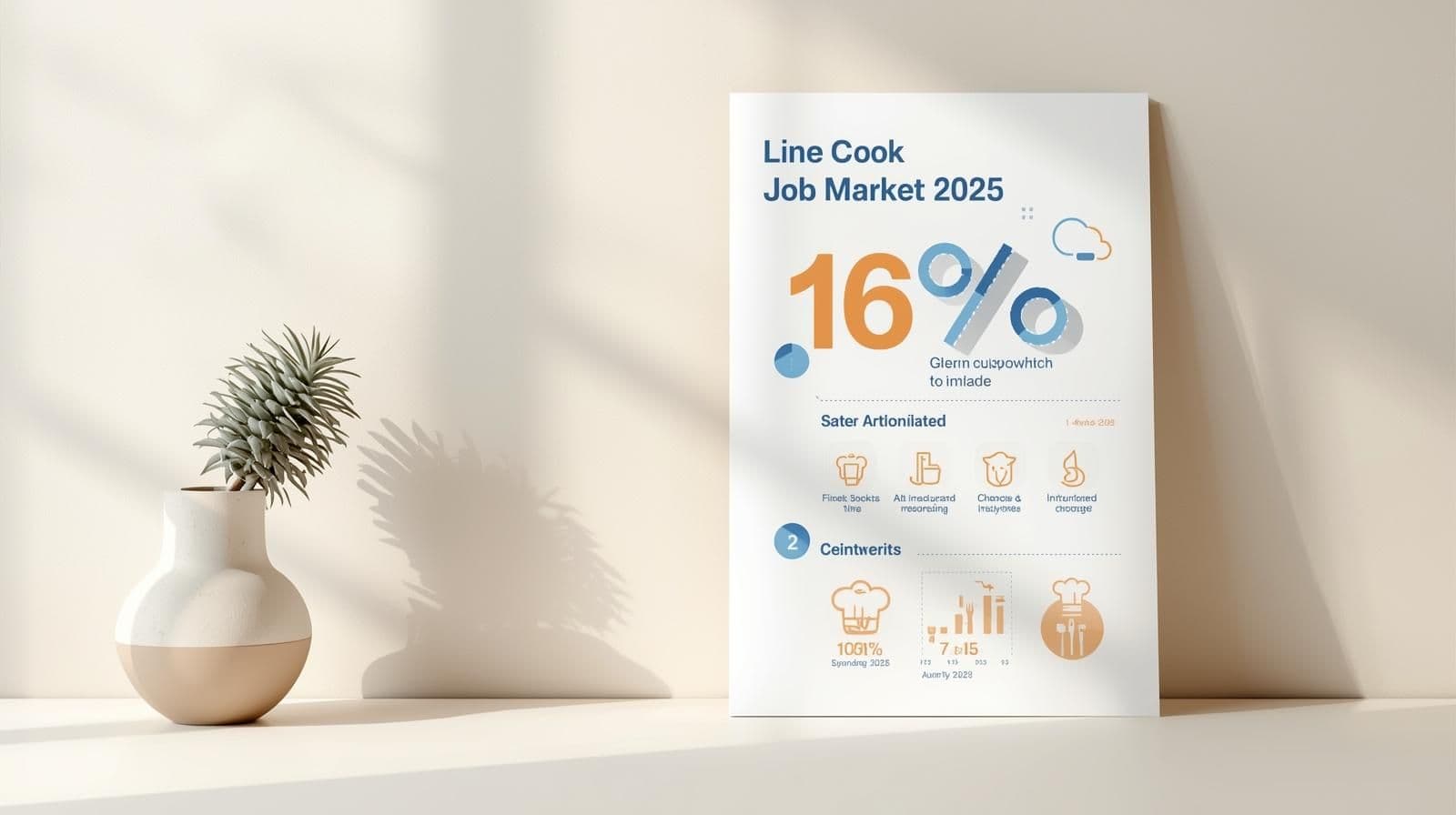Line Cook Resume Guide: Templates & Expert Writing Tips

Writing a line cook resume that stands out in today's competitive restaurant industry requires more than just listing your work history. Your resume needs to tell the story of your culinary skills while showing how you handle the fast-paced kitchen environment that defines modern dining.
Your line cook resume template should showcase your ability to work under pressure, maintain food safety standards, and contribute to a team's success. This guide will walk you through creating a resume that highlights your strengths and gets you noticed by hiring managers.
Why Your Line Cook Resume Matters More Than Ever
The restaurant industry has changed dramatically in recent years. According to the Bureau of Labor Statistics, cook employment is expected to grow 16% between 2021 and 2031. However, this growth varies by restaurant type. Traditional restaurants expect a 37% increase as dining out becomes more popular again, while fast-food positions may decline due to automation.
 This shift means your resume must clearly show which type of kitchen environment you excel in. Whether you're applying to fine dining establishments, casual restaurants, or specialized kitchens, your resume needs to match their specific needs.
This shift means your resume must clearly show which type of kitchen environment you excel in. Whether you're applying to fine dining establishments, casual restaurants, or specialized kitchens, your resume needs to match their specific needs.
Essential Components of a Strong Line Cook Resume
Start with a Compelling Profile Section
Your profile section acts as your personal elevator pitch. In 3-4 sentences, capture what makes you valuable as a line cook. Focus on your experience level, specialties, and key achievements that relate to the job you want.
For experienced cooks: Line cook with 8+ years of experience in high-volume kitchens. Proven ability to manage multiple stations while maintaining quality standards. Skilled in both traditional and modern cooking techniques with expertise in Mediterranean cuisine.
For entry-level positions: Dedicated culinary professional with strong foundation in food preparation and kitchen safety. Experience in fast-paced environments with passion for learning new techniques. Committed to maintaining high standards and supporting team success.
Highlight Your Professional Experience
Your work history section should focus on achievements rather than just duties. Use specific numbers when possible and show how you contributed to your kitchen's success. As experts from ResumeBuilder.com note, showcasing achievements with action verbs and quantified results helps you stand out in a competitive kitchen environment.
Instead of writing "Prepared food items," try:
- Prepared 200+ entrees per shift while maintaining 98% order accuracy
- Reduced food waste by 15% through improved portion control
- Trained 3 new team members on proper knife techniques and safety protocols
Each bullet point should start with an action verb and demonstrate your impact. Words like "prepared," "managed," "improved," and "collaborated" work well for line cook positions.
Skills That Matter to Employers
Your skills section should include both technical abilities and soft skills that make you effective in kitchen environments. According to Beamjobs.com, as a line cook, you're the pro when it comes to food safety, preparation, cleanliness, culinary creativity, and exceptional customer service.
Technical Skills:
- Food safety and sanitation procedures
- Knife skills and food preparation techniques
- Grill, sauté, and fryer operations
- Recipe execution and portion control
- Inventory management
- Kitchen equipment maintenance
Essential Soft Skills:
- Time management under pressure
- Team collaboration
- Communication with kitchen staff
- Adaptability to menu changes
- Problem-solving during service
- Attention to detail
Tailoring Your Resume for Different Kitchen Types
Fine Dining Positions
Fine dining kitchens look for precision, creativity, and attention to presentation. Emphasize your experience with:
- Complex cooking techniques
- Menu development participation
- Quality control standards
- Presentation skills
- Experience with premium ingredients
Fast-Casual and High-Volume Kitchens
These environments prioritize speed and consistency. Highlight:
- Volume capabilities (meals per hour/shift)
- Efficiency improvements you've made
- Multi-station experience
- Speed without sacrificing quality
- Peak hour performance
Specialty Restaurants
For restaurants focusing on specific cuisines or dietary needs, showcase:
- Relevant cultural cooking knowledge
- Specialized techniques (sushi, BBQ, vegan cooking)
- Ingredient expertise
- Dietary restriction experience
- Cultural authenticity understanding
Education and Certifications
While formal culinary education isn't always required, it can set you apart. Include:
Culinary Education:
- Culinary arts degrees or certificates
- Specialized training programs
- Apprenticeships completed
Important Certifications:
- ServSafe Food Handler certification
- ServSafe Manager certification
- Local health department certifications
- Allergen awareness training
- HACCP certification
Common Resume Mistakes to Avoid
Being Too Generic
Many line cooks make the mistake of using the same resume for every application. Each restaurant has different needs, so customize your resume accordingly. A pizzeria values different skills than a steakhouse.
Focusing Only on Duties
Don't just list what you did – show the impact you made. Numbers and specific achievements make your resume memorable. Zety.com emphasizes the importance of showcasing relevant skills, achievements, and experience to stand out to hiring managers.
Ignoring Keywords
Many restaurants use applicant tracking systems (ATS) to screen resumes. Include relevant keywords from the job posting naturally throughout your resume.
Poor Formatting
A cluttered or hard-to-read resume gets discarded quickly. Use clean formatting with clear sections and consistent fonts.
Line Cook Resume Template Structure
Here's how to organize your line cook resume template:
| Section | Content | Tips |
|---|---|---|
| Header | Name, phone, email, city | Keep it simple and professional |
| Profile | 3-4 sentence summary | Focus on your strongest selling points |
| Skills | 8-12 relevant skills | Mix technical and soft skills |
| Experience | 3-5 positions with achievements | Use bullet points and action verbs |
| Education | Relevant training and certifications | Include completion dates |
Optimizing for Applicant Tracking Systems
Many restaurants use ATS software to filter resumes before human review. According to My Perfect Resume, ATS optimization is crucial for getting your resume noticed. To pass these systems:
- Use standard section headings (Experience, Education, Skills)
- Include keywords from the job posting
- Avoid graphics, tables, or unusual formatting
- Save as a Word document or PDF as requested
- Spell out abbreviations (write "Point of Sale" not "POS")
Sample Achievement Statements
Use these examples to inspire your own achievement statements:
- Maintained 99% food safety compliance during health inspections
- Increased kitchen efficiency by 20% through improved prep organization
- Successfully handled 300+ covers during peak service without quality issues
- Mentored 5 new hires in proper cooking techniques and safety procedures
- Reduced ingredient costs by 12% through better portion control
- Collaborated with chef to develop 3 new menu items that increased sales
Final Tips for Success
Keep It Relevant
Focus on the last 10-15 years of experience unless older positions are highly relevant. A one-page resume works for most line cooks, while experienced professionals might need two pages.
Proofread Carefully
Spelling and grammar errors signal carelessness – not a quality restaurants want in their kitchens. Have someone else review your resume before submitting.
Include a Cover Letter
A well-written cover letter shows your communication skills and genuine interest in the position. As noted by Resume Trick, writing a good cover letter when pursuing a line cook job is essential to make sure your application stands out from the crowd.
Follow Up Professionally
After submitting your application, a polite follow-up email after a week shows initiative and continued interest.
Preparing for Your Job Search
Your resume is just the first step. Be prepared to:
- Demonstrate your knife skills during interviews
- Discuss your experience with different cooking methods
- Explain how you handle kitchen pressure
- Show knowledge of food safety regulations
- Describe your teamwork approach
Ready to Create Your Winning Resume?
Crafting the perfect line cook resume takes time and attention to detail – just like preparing a great dish. Your resume should reflect your culinary skills, work ethic, and ability to thrive in demanding kitchen environments.
Remember that each application is an opportunity to showcase what makes you unique as a culinary professional. Whether you're just starting your career or looking to advance to the next level, a well-crafted resume opens doors to better opportunities.
For the most professional results and to ensure your resume stands out from the competition, consider using HyperCV to create a polished, ATS-optimized resume that gets you noticed by hiring managers. With the right resume in hand, you'll be ready to take the next step in your culinary career.